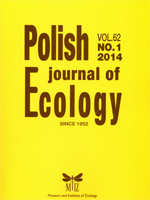Changes in field communities with Illecebrum verticillatum at the north-eastern limits of the species range in Poland were recorded with the phytosociological method over the years 1994–2010. The material studied consisted of 136 phytosociological relevés which were subjected to numerical classification and ordination according to habitat gradients by the Detrended Correspondence Analysis (DCA). Changes in communities and habitats were assessed using the following indicators: species richness, the Shannon-Weiner index of biodiversity (H), Simpson's index of domination (C) and floristic value (FV). The values of these indicators were statistically analysed using the Kruskal-Wallis test at P <0.05. Spearman's rank correlations were calculated using Statistica 10 to determine relationships between the indicators analysed.
On the basis of numerical classification 7 types of phytocoenoses were identified, representing communities at the initial and final phases of the study. At the beginning the communities included: Arnoserido-Scleranthetum with Illecebrum verticillatum, in stubble fields and Spergulario-Illecebretum verticillatum and Digitarietum ischaemi with Illecebrum verticillatum in root crops; at the end of the study they included: Vicietum tetraspermae and the community with Aperion spica-venti in cereals and the diverse, floristically common association Echinochloo-Setarietum. The communities identified reflected changes in the phytocenoses of the permanent sites due to intensification of field production. The comparison of indicators of species number, index of biodiversity and index of domination revealed significant differences. The analysis of habitat indicators according to Ellenberg demonstrated that soil temperature and moisture decreased whereas soil pH and nitrogen increased. The comparison of the taxonomic value of a species group for the association Radiolion linoidis and floristic value of communities revealed that species from the from the alliance R. linoidis were disappearing at a rapid rate.





